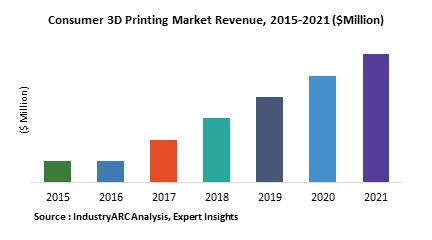The consumer 3D Printing market was valued at $ 1,744.49 million in 2017 and is anticipated to grow at CAGR of over 22% during the forecast period 2018-2023. Consumer 3D printers are gaining prominence given the relatively low cost of the device and the ability of the device to print a product with complex design with ease. Majority of the revenue is generated from jeweler printing which accounted for over $385.02 million in revenues in 2017.Small and Medium Scale Jewelers manufacturers and design hobbyists are opting for 3D printers which produces accurate designs within a very short span of time. Huge demand for custom designs is driving the consumer 3D printer market in the jeweler segment and is anticipated to continue its dominance through the forecast period 2018-2023.

- Proof of concept and prototyping are the major end user applications for consumer 3D printing. Majority of the consumers in the consumer 3D printing market use it to demonstrate a product during development phases. Clothing designers have started 3D printing cloths. This is allowing the designers not only to develop different designs but different applications such as lightweight bulletproof clothing for defense are also being prototyped using consumer 3D printers. Many companies have started to offer DIY 3D clothes printing through e-commerce sites. This allows consumers to 3D print their own designs according to their convince and re-market them.
- Consumer gifts and keepsakes, 3D printer service bureaus popping up around the world create bespoke consumer products using 3D scanner and 3D printer technologies. For example, pets, children and brides and grooms are scanned and 3D printed figurines are produced from the scans as lasting keepsakes. Common household objects are also scanned, customized and 3D printed as gifts or for personal use.
- Amazon has received a patent for new retailing systems which enables the company to process orders for custom 3D printed items. Customers can get their designs 3D printed through the service, and they receive them through the mail or pick them up. So this retailing system could bring many advantages offered by 3D printing to manufacturing projects, to the needs of an everyday consumer.
- Evaluate market potential through analyzing growth rates (CAGR %), Volume (Units) and Value ($M) data given at country level – for product types, end use applications and by different industry verticals.
- Understand the different dynamics influencing the market – key driving factors, challenges and hidden opportunities.
- Get in-depth insights on your competitor performance – market shares, strategies, financial benchmarking, product benchmarking, SWOT and more.
- Analyze the sales and distribution channels across key geographies to improve top-line revenues.
- Understand the industry supply chain with a deep-dive on the value augmentation at each step, in order to optimize value and bring efficiencies in your processes.
- Get a quick outlook on the market entropy – M&A’s, deals, partnerships, product launches of all key players for the past 4 years.
- Evaluate the supply-demand gaps, import-export statistics and regulatory landscape for more than top 20 countries globally for the market.










Comments (0)
Post a Comment